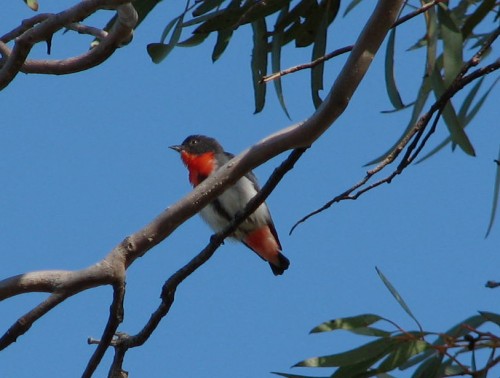A Mistletoebird pays a quick visit
Yesterday my wife and I were taking a short break from the jobs we had been doing. Sitting on our back veranda we were enjoying the lovely sunny spring weather we have had this week. It was afternoon tea time and we were enjoying a well deserved cup of tea. The back veranda has been a bit of a mess over the winter months and the weather has been too cold to spend too much time cleaning it up. Now that the spring weather is here we had a renewed enthusiasm for being outside.
While we sat there we enjoyed the constant parade of birds hopping around in the garden nearby. Many others were calling and we enjoy trying to identify them by call alone, a good way of honing one’s identification skills. Our resident Superb Fairy-wrens entertain us every day, as do the Mallee Ringneck parrots, the Eastern Rosellas and the Galahs. We can’t work out if the Galahs are actually nesting or not. The Spotted Turtledoves often join in the chorus and in recent days we have had the delight of Peaceful Doves also hanging around near the house.
As we sat there we were delighted to have a female Mistletoebird fly in and alight on a bush in full view just three metres from us. We were able to see the soft, dull grey colours of the feathers on her back, a stark contrast with the blue-black feathers of the male (see photo above). I didn’t have the camera handy, and the bird flew off after less than a minute, so I have shared a photo of the male taken some years ago. I do have one photo of the female, but unfortunately it is not in focus. Sigh.
I cannot categorically say that this is a resident species in our garden and on our 5 acre property, but it is certainly a regular visitor. I hear its call almost every week. Many years ago this was the first species to nest in one of the trees we planted after moving here. There may have been other species before it, but this was the first one we positively recorded doing this. The nest is a delicate pear-shaped container with a small entrance near the top. It is made primarily from spiders’ webs, small leaves, lichen and other soft materials, and hangs from small twigs or leaves. They are just coming into their breeding season, so I need to keep an eye open for a nest. This species is found throughout mainland Australia except in the driest regions. It is not present in Tasmania.
Further reading:
- Beautiful Mistletoebird
- Great Birding Moments #3
- If you click on the name of any of the bird species mentioned in the text above, you can go to other articles about that species.
Dusky Turtle Dove, Ethiopia
The Dusky Turtle Dove (Streptopelia lugens) was a challenging bird for me to photograph during my visit to Ethiopia last December. Although they were relatively common on the school campus where my daughter was teaching, during our 2 week stay this species was almost reclusive in nature. One evening I stealthily chased one around the playground trying to get a photo. It was almost dark and the flash needed to be employed, but the bird keep moving around quickly and generally just out of effective reach of the flash.
On another occasion one bird was feeding in the car park right out in the open. Again it was in poor light and the bird keep moving around rapidly, to quickly to get the camera focussed on it. All those shots were blurred. In the end, I only managed to get 2 photos reasonable enough to show here. That’s nature photography I guess. You win some, you lose some – and the rest are just plain challenging.
Doing a little research on this species I have found little in the way of information online. It appears that both males and females of this species, along with closely related species, are able to produce “crop milk”, a soft lumpy substance resembling cheese. When it is fed to the young it nourishes them with its high protein content. Read more about it here.


